Case Releases:
1.0 In general IoT Decision Framework
2.0 From UBI Data to Telematics Data
3.0 OBD-II Port, for electro-fitting of vehicles
| #Intro |
| I started to explore usage-based insurance for automotive industry and fleet management, realized other use cases by rethinking the possibilities of telematics data and how close todays normal car are to become smart. Only a small step till electro-fitting is missing and a deep dive into the layer of cloud platform is also part of this case and still in progress… |
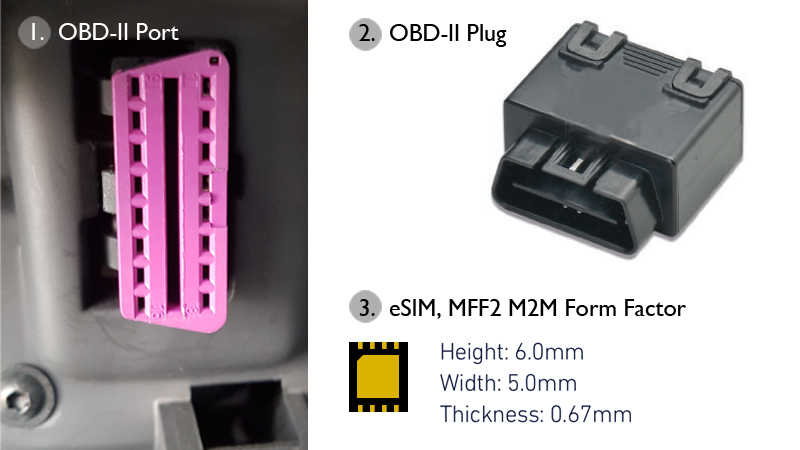
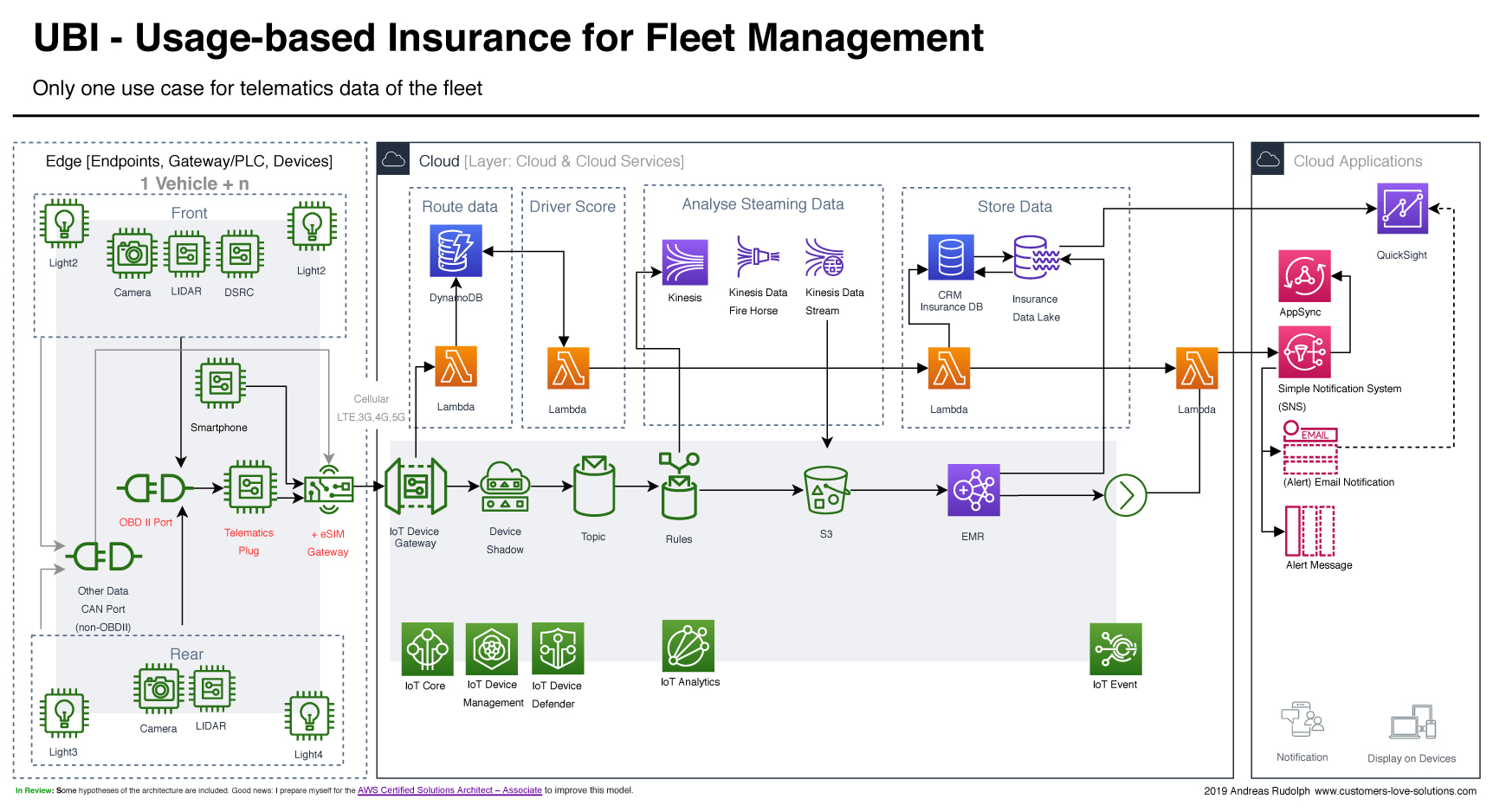
| #Problem Statement |
| If you own a fleet of several thousand vehicles, one of your business goals is to reduce all cost elements, also for insurance. And if you transport e.g. dangerous goods the insurance rate is much higher than for general goods. The average cost of linehauls is about ~12% of the overall costs. |
| #Value Proposition. “The Solution” |
| Use a telemetrics data model in the area of fleet management and provide a value also for the use case usage based insurance. The value for logistics companies & fleet owners is real-time transparency of available capacities, cost optimization, in this case especially for insurance premiums, but also an improvement to monitor the SLA of 3rd party carriers. |
| #Product |
| Aggregate via hardware telemetrics data from the fleet and manage it. Generate alerts for drivers, 3rd party carriers, LogisticCompanies and visualize service level, risk level, rest capacity till 8 hours driving time and insurance cost control. Usage based insurance for fleet management means, we pay only insurance rate if the linehauls are on the road or the dangerous goods are still loaded. |
| # MVP / Release Goal |
| Monitor the relevant telematrics data like, 1. delta of speed vs. allowed speed, 2. usage of breaks, 3. Cornering and 4. Max driving time(8h) 5. accident to mention to most relevants. Display these aggregated data in different views for the insurance company, logistic company, carrier/3rd party, the driver. Align at the end of year the insurance premium in relation to the aggregated streaming data. |
| #Target Costumers / Sector Industries |
| Fleet Owners or Companies using several vehicles in their core business, like in Logistic Industry. |
| # Size of Target companies |
| Large fleet Management Companies / logistic industry > 1000+linehauls are minimum. |
| #Summary & Key learnings |
| Only 4% of todays container are smart, but it’s no greenfield anymore! Buy or partner, but not build an own Smart Container is focus. And at the end track asset states is only part of a holistic IoT strategy including a data hub to earn money with assets and it’s data. I started to explore usage-based insurance for automotive industry and fleet management and realized, there is much more value then insurance cost reduction based on telemetric data including UBI. I created my User-Value-Map to show the possibilities below. While analysing the telematricsdata of a vehicle, I realized, that there is already the OBD-II Port (On Board Diagnostic) in my car to export most data and only a OBD-II-Plug + eSIM is missing to make every vehicle smart, because the OBD-II port is duty since 2006! This is a real Brownfield approach: Electro-fitting of devices/vehicles! But also to get further user feedback I interviewed my purchase department, fleet operations and partners from a telecommunication provider tounderstand better the market needs. |
Some Links:
https://www.msc.com/technology
https://www.gatewaycontainersales.com.au/smart-shipping-containers-avoiding-damage-loss-and-theft/
https://blog.bosch-si.com/industry40/container-4-0-smart-transport-high-seas/
https://steemit.com/steemit/@langitatas/smart-containers-with-blockchain-technology
https://www.flexport.com/our-tech-platform
https://blogs.dnvgl.com/sustainability/2017/09/smart-containers-disrupt-seafood-industry/
The IoT Decision Framework:
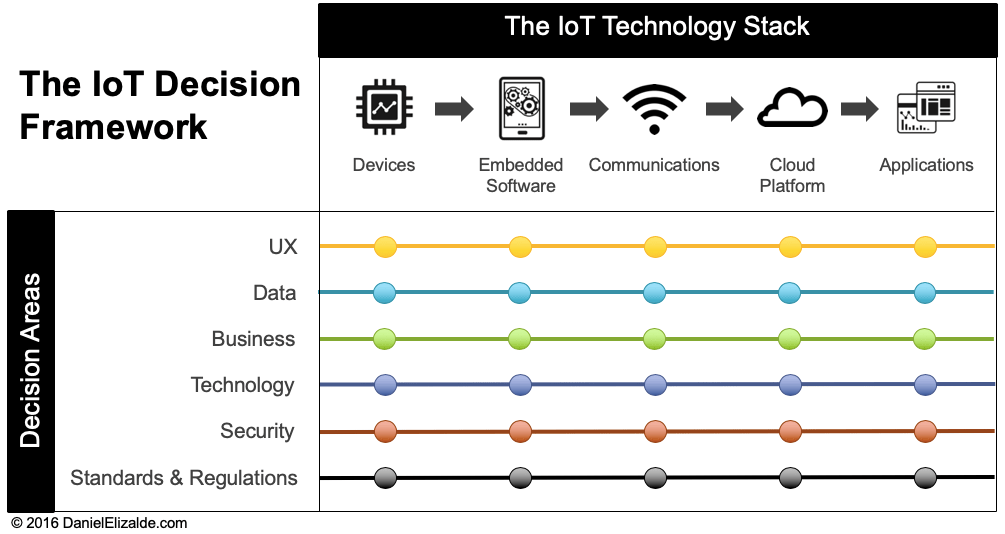
To learn more about the IoT Decision Framework, please click here https://danielelizalde.com/iot-decision-framework/
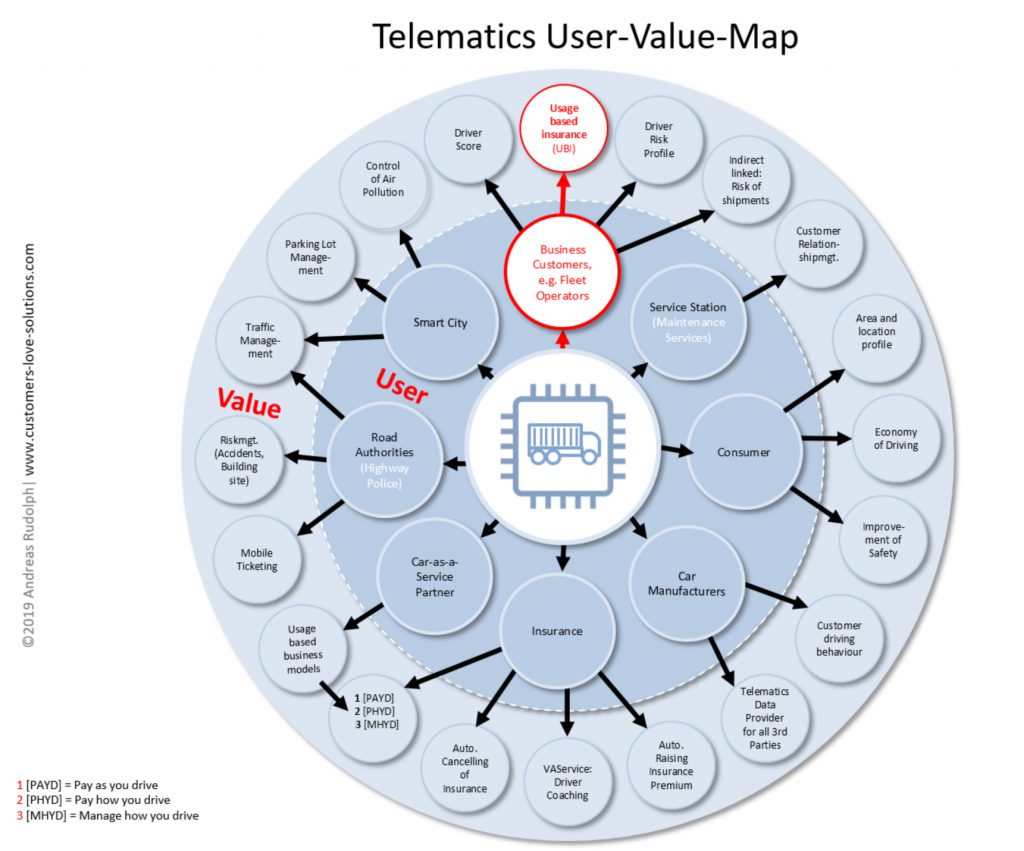
As an introduction to the area of UX for UBI, I build the Telematics User-Value-Map. Call it a strategic view and a visualization of the high level roadmap to showcase a variety of possible use cases beyond the UBI only to monetize the telematics data from the fleet.
| #UX |
| This area is about identification of different user and roles using the solution, before starting the development cycle to achieve a holistic view of the purpose to build or buy the solution. That means for their activities, there is a different usage, therefore are maybe other features required. In the development team this is done e.g. in JIRA in tickets to create Themes > Epics > User Stories including UAC, in the agile sprint cycle. Core questions to answer are: Who is the Customer? Who the User? What is the key value for each of them? What is in essential for MVP vs. Backlog and the Roadmap? Do we have different user groups? Customers, extern vs. intern partners? Describe your personas as clear as possible to help all team members you need to build this solution. External User Group: —————————————— 1. Tim Trucksky, 38 y., Truck Driver, [primary customer persona], ext. Customer Activities/Responsibilities: 1.1. Pre-Alerts & Alerts 1.2. App/Dashboard: Receive 5 states of his truck to drive secure (incl. real-time data & historical reports of his truck) —————————————— 2. Oliver Owner, 44 y., Owner of 3rd Party Carrier, ext. Customer Activities/Responsibilities: 2.1. Manage business & staff (driver) 2.2. Monitor fleet/trucks —————————————— 3. Ivy Insura, 32 y., Insurance Agent, ext. Network Partner Activities/Responsibilities: 3.1 Monitoring of fleet per logistic company, 3rd party carrier 3.2 Review annual insurance premiums in relation to risk score —————————————— 3. Edwin Engineer, 35y. Engineer for installation & maintenance of hardware and sensors at the truck. Activities/Responsibilities: 4.1 Install & Provisioning Hardware and sensor at new trucks 4.2 Live and healthy monitoring of hardware & sensors 4.3 Maintenance, if required —————————————— Internal User Group: 4. Larry Lord of Carriers, 29 y., Fleet Manager of 3rd Party Carriers, int. User Activities/Responsibilities: 4.1. Decision Maker to mitigate possible suppy chain risks 4.2. Monitor Costs, SLA of each Carriers in real-time 4.3. Get monthly reports of KPI’s 4.4. Manage Transport Management (TMS) 4.5. Recommendation for Carrier Contract Management ========= MVP / 1. Release Goal ========= Prio – Persona – Requirement (Activity) 1 – Edwin Engineer -Install the edge device in truck 2 – Edwin Engineer -Maintenance the edge device in truck 3 – Tim Trucksky –Pre-Alert and Alert via Notification 4 – Larry Lord of Carriers – Decision Maker in case of risk 5 – Oliver Owner – Manage business & staff (driver) 6 – Ivy Insura -Monitor insured fleet & review annual insurance premiums 7 – Larry Lord of Carriers –Cost and SLA monitoring ========== Backlog =========== 8 – Tim Trucksky –Dashboard to review real-time and historical data … |
| #Business |
| The market growth of UBI shown below offers a lot of market opportunity. +255% from 2017 to 2023 in the US. The area business is were the rubber hits the road! Good to review your business model and to check, if ROI is given! The area of revenue is divided into one-time and recurring revenue, in the overall layer solution in the stages of customer lifecycle management, CLM are: Install, Provision, Onboard, Operate, Maintain, Decomission. But as well there are revenue opportunities on the level of the IoT Technology Stack: Device, Device Software, Commuications, Cloud Plattform, Cloud Applications. Same logic applies to the cost: One-time and recurring cost at the CLM level and per Technology Stack. |
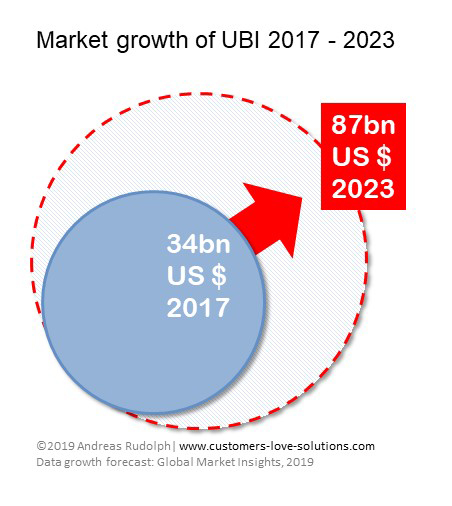
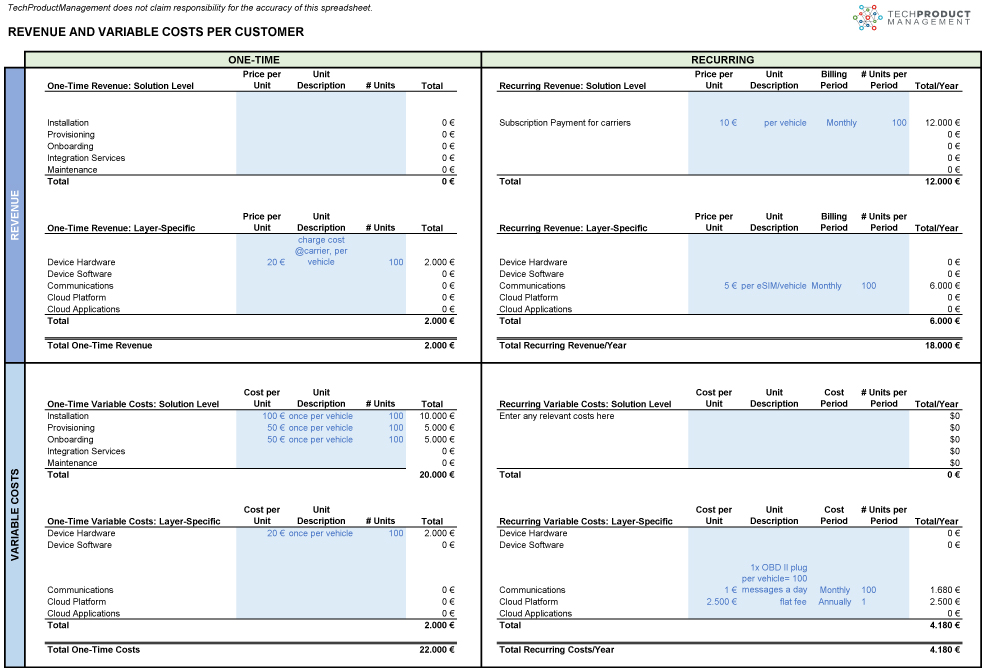

Build vs Buy Decisions per Layer is part of the Business area.
| Layer | Build vs Buy Decisions per Layer part of the Business area. |
| Device | Buy off-the-shelf. OBD-II plugs including eSIM are a scaled hardware device. |
| Device Software | Buy from your key provider you have choosen for the solution. |
| Communications | Buy from a telecommunications provider, maybe a communications platform like Aeris offering eSIM as well, to switch between the local connectivites available and cost effective. More than traditional Telecommunications provider would offer! |
| Cloud Platform | Buy from your “nearly” full layer provider or partner. Two or more layers is recommended. |
| Cloud Applications | Build and customize your reports and alert messages following the rules of your business. |
| Insurance Premiums General Goods vs. Danger Goods |
| In this case our carrier pays ~6.000 € p.a. insurance premium for general goods and ~18.000 € p.a. for dangerous goods per vehicle. Worst case scenario 180.000 € p.a. if only D.G. are loaded. But in a smart world it’s trackable which goods we carry and we only pay for usage of the vehicle. As the fleet management of a logistic company we could charge the carrier for offering the opportunity to reduce his insurance premiums on the long term. And also the device hardware OBDII-Plug and eSIM monthly fee are costs for the carrier. One time costs for installation, provisioning and on boarding the logistics company pays. The idea is by Subscription Payment of the carriers the logistics company earns additional revenue, while the carrier on it’s own can reduce his insurance costs extremely, by paying only for usage of each truck. Dangerous goods declaration: https://www.dhl.com/en/express/shipping/shipping_advice/dangerous_goods.html https://www.iata.org/whatwedo/cargo/dgr/Pages/shippers-declaration.aspx |
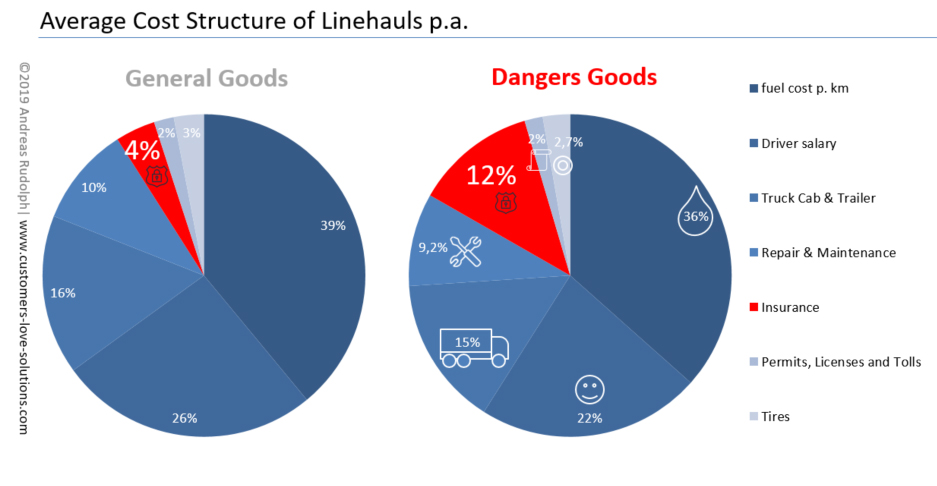
| #Data |
| From my research and additional feedback of a telco provider, I identified the difference of traditional insurance models and usage based insurance models in relation to data types and sources. The old insurance infrastructure used a lot static data, stored in the Insurance CRM Database starting with vehicle manufacturer data like vehicle type, car brand, engine power, age, sex in the customer lifecycle stage of acquisition. Additional manual input must be requested of end customers. Annual data like mileage per year, numbers of car users and authentication of them, still same local area of living(address data)? are only static data based on customer confidence. For Usage Based Insurance static data is not enough, streaming real-time data is required! But don’t reinvent the wheel! Since 2006 all vehicles are equipped with the On Board Diagnostic Port, in 2nd Gen. including 16PIN‘s to acquire Vehicle Sensor Data (VSD) for the vehicle emission measurement original used. Vehicle Sensor Data (VSD) including location-based data (LB-VSD) such as location, speed, and moving direction, and surrounding traffic data (ST-VSD) under Connected and Automated Vehicles (CAV) environment. To get these data from vehicle sensors we only need an OBD-II plug as a device gateway and an eSIM to build the connectivity to the IoT device gateway in the cloud. To track smartphone usage as well while driving and to identify the car user, the smartphone is also linked to the plug in the function as device gateway. Acceleration, Deceleration, real vehicle Speed vs. allowed speed, cornering and distractions of Smartphone are additional states required in real-time for UBI. At theend the step towards UBI and smart vehicles is smaller if you understand, that the most data is already available at the OBD-II and only a plug and eSIM is missing to send data to the cloud. Further thoughts about resolution and sampling rate per sensor is not needed, it’s existing car infrastructure and no greenfield approach anymore! Further links: – Vehicle sensor data-based transportation research: Modeling, analysis, and management https://cutt.ly/keijZT0 – Get Your OBD Port Location: https://www.carmd.com/obd-port-location/ – Wikipedia On-Board Diagnostics: https://cutt.ly/9eillOm |
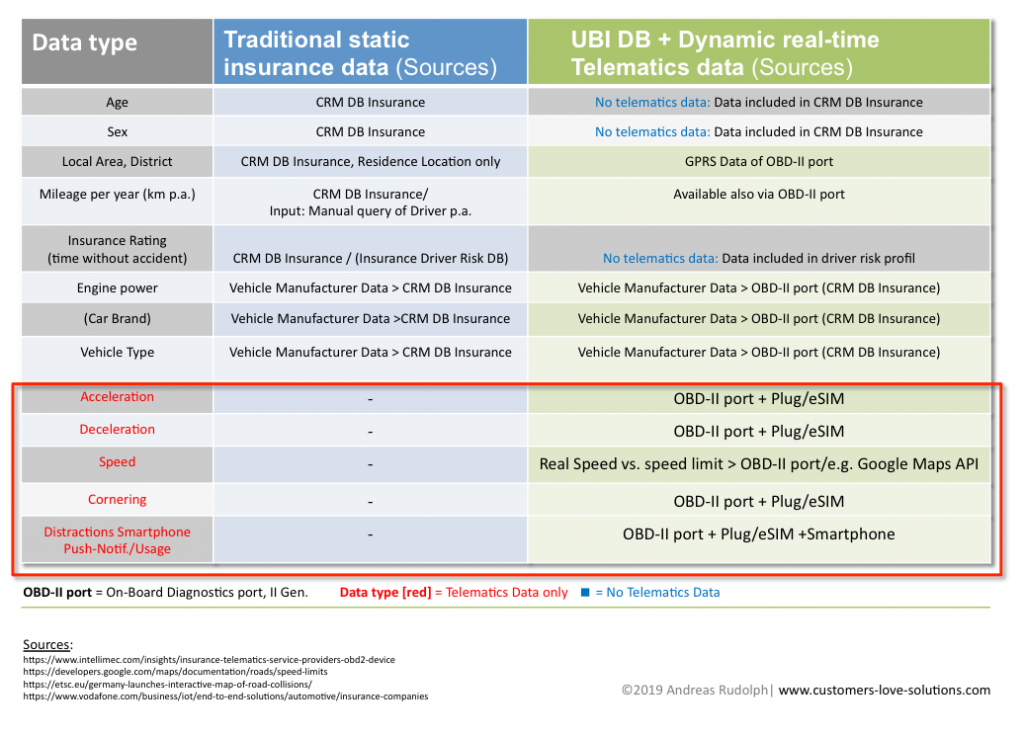
| #Technology |
| This architecture model show cases how to manage Vehicle Sensor Data (VSD) from the OBD-II port via a OBD-II plug including eSIM and gateway functionality to transfer vehicle data to the cloud. But I also learned about cloud components beyond theIoT Core with e.g. Device Shadow, Topics and Rules to enable asynchronous communication between IoT and the device if it’s only intermittently connected or temporary there is no connectivity. […] https://aws.amazon.com/de/blogs/big-data/integrating-iot-events-into-your-analytic-platform/ https://aws.amazon.com/de/blogs/aws/aws-iot-greengrass-and-machine-learning-for-connected-vehicles-at-ces/ https://aws.amazon.com/de/automotive/connected-vehicles/ https://aws.amazon.com/lambda/?nc1=h_ls Coming from the IoT Technology Stack from Daniel Elizalde, my next step is, get deeper in native cloud. Therefore I prepare myself for the AWS Cloud Solution Architect Assosiate, not only to improve my architecture models like this. So this area is show case and self-learning arena: Two benefits in one! |
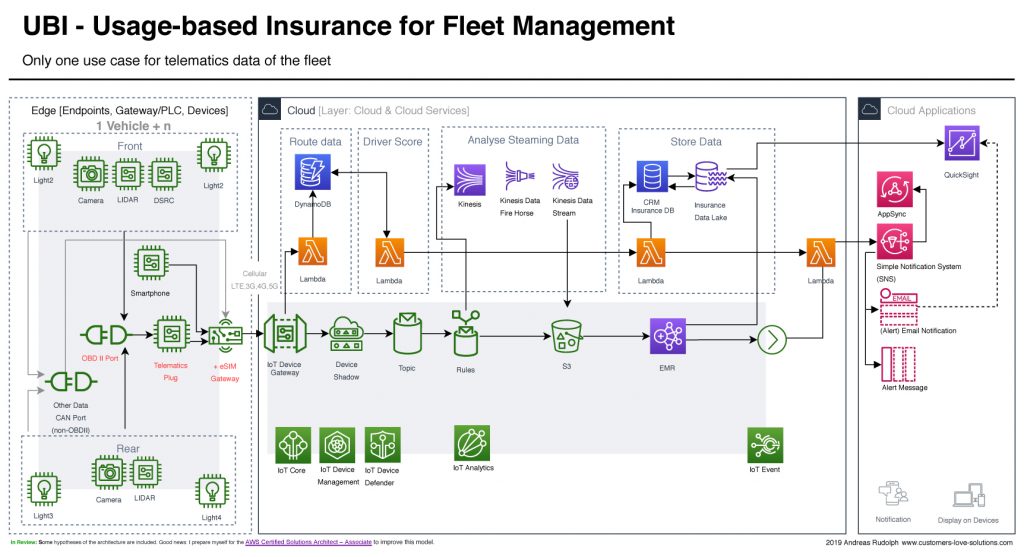
| #Security |
| In general security is a topic for OT and IT in all layer of the IoT stack of technology! Real world security as well as for cyber security has to be ensured. Additional industry, country specific requirements are relevant! |
| Device | – Automatisation of Provision and Decommission in remote-areas and in your company buildings – Use devices prepared with eSIM’s, Device Certificates before provisioning – Limitation of physical access to the OBD-II plug and eSIM, maybe a lock? – While 1st time of OBD-II plug is connecting to the cloud, access is only authorized for devices with valid devices certificates |
| Device Software | – Over the air Updates (OTA), – Security Alert from IoT Device Defender – Accept only devices with valid devices certificates signed of Certificate Authorithy – A reboot process must be ensured – Store data temporary if Connectivity breaks down for a short periode of time (max. 48h) |
| Communications | – Restriction of IP-Adress for reception of data – Monitor any unusal interuptions of connectivity |
| Cloud Platform | – Operational Security Attestation C5 (BSI standards) https://aws.amazon.com/compliance/bsi-c5/ – Location of storage: No mirrored data storage outside the EU! Especially not in the US! – Define security guideline – Define a role like: Information Security Officer (ISO) – Link to your Identity & Access Management (IAM), like Active Directory, OpenLDAP- or Jump-Cloud-Accounts (JumpCloud: Directory aaS) -Security Rules & Rights – Delete the initial root password! – PW rules – Allow only required, timed access and rights – Delete unnecessary data – Encrypt all stored data! Store no data unencrypted! – Security Audits, as part of your Security Guideline |
| Cloud Applications | – Security- & Update for all applications(App’s, portal, download server,…) – Use state-of-the art technology stacks, also of 3rd party libraries and software licences you embed to your application |
| #Standards & Regulations |
| It’s always relevant to know the standards & regulations specific for your industry, the country or maybe your customers or company, before first roll out. #General: – EU Data Protection Regulation – General Data Protection Regulation (GDPR) Center (eg. AWS) https://aws.amazon.com/compliance/gdpr-center/ – European Telecommunications Standards Institute (ETSI) ISO/IEC 27018 https://www.iso.org/standard/61498.html – Compliance Program: https://aws.amazon.com/de/compliance/programs/ – BSI C5: Cloud Computing Compliance Controls Catalog (C5) , https://aws.amazon.com/compliance/bsi-c5/?nc1=h_ls – Data sheet of devices. Specific attributes mentioned ? – Workers Council: Are your drivers internal colleagues? A permission of workers council is needed before tracking vehicle sensor data (VSD). #Automotive Industry Standards: – Trusted Information Security Assessment Exchange (TISAX) (by VDA) https://aws.amazon.com/compliance/TISAX/ |
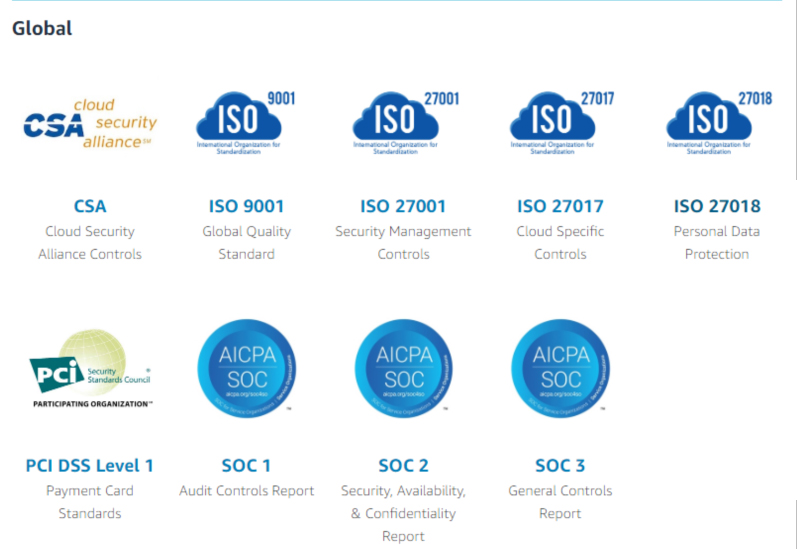

| Device | – TÜV „Technischen Überwachungsvereine“. Technical Monitoring Authority to get road traffic licensing. – Road Traffic Licensing: Asked solution provider of the OBD-II plug, like Vodafone. Check the data sheets |
| Device Software | n/a |
| Communications | n/a |
| Cloud Platform | n/a (above in genral) |
| Cloud Applications | n/a |